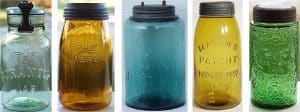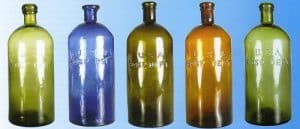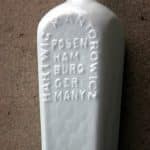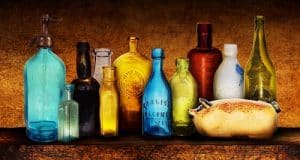Exploring Antique Technologies
By Kary Pardy
Glass is blown, pressed, molded, and patterned, but sometimes the most stunning features come from within. Spanning almost all colors of the rainbow, the spectrum of colored glass has always dazzled collectors as much as the forms themselves. Glassmakers keep their specific color formulas a closely guarded secret, however, adding an air of mystery to each beautiful piece.
Despite the secrecy behind different maker’s colors, we do know from basic glassmaking chemistry how the most common shades are added to our favorite bottles. Bottle color is tempting to use as a diagnostic, but given the variety of colors and styles, color is not a reliable indicator to date or fully identify a bottle. This article will offer a few tips associated with specific colors but will focus mainly on the illustrating and explaining the most common hues that you will see in your bottle-collecting quest.
The Basics
Common bottle glass is made primarily with three ingredients, sand (silica plus iron and other assorted rock and mineral particles), soda (soda-ash, or potash), and lime. Silica is the main ingredient and tends to make up anywhere from 60% to 80% of the glass’s composition. Soda is added to lower the melting temperature of the silica, and lime helps to stabilize the concoction because without it, the mixture would dissolve in water.
Pure sand with high concentrations of silica is preferred for color control; it’s the additives that ultimately give glass its color, or lack of. Glass made with pure silica would be colorless, but that would be expensive and hard to produce in mass quantities, as with bottles. Simple bottle glass in its natural state would be shades of green from the presence of iron impurities. What follows is a basic description of the chemistry involved in achieving your favorite colors. Glassmaking is complex and we can only skim the surface, but we can appreciate the ancient technology behind what we collect.
Colorless
To take glass from green to colorless (typically a term preferred over “clear”), a glassmaker would need to add items to reduce the affect of the iron found in sand. Lead, flint, manganese, selenium, and arsenic were common additives. Flint tended to be used in the early 1800’s, with lead taking over in the mid-19th century. Manganese was another option up until the early 20th century, and if this type of glass was exposed to sunlight for long periods of time, it would take on purple shades. Selenium and arsenic would come with tints of straw or amber. While these tints do not overtake the bottle itself, they will be visible by looking at the thickest part of the bottle, such as at the side of the base.
Opaque White (Milk Glass)
As the name suggests, this glass is milky white and immediately recognizable. Milk glass was usually made by adding fluorides, phosphates, and tin or zinc oxide. The Society for Historical Archaeology also adds animal bones or bat guano to the list of potential colorants due to their calcium and phosphates. Just as colorless glass is not truly devoid of color, milk glass is usually not purely white. Some opalescence or light tints are sometimes visible around bottle edges. Manganese strikes again here and can produce lavender tints when it is present in milk glass and exposed to sunlight.
Milk glass bottles tended to hold cosmetics and cold creams, but also show up occasionally as bottles for ink, liquor, bitters, and sometimes food.
Reds
Red glass, as used in Mary Gregory style objects, gets its tones from adding gold to the mix. Gold oxide, and the quantity used, determines the richness of the red. Deep reds are the result of heavy-handed application, while small amounts produce pinks and cranberry shades.
Be careful, however, red glass can be sneaky. Check that your red glass color (or any color, for that matter) is internal to the glass itself and not painted. Red is a popular color to paint on glass surfaces in conjunction with frosted accents, a process known as “flash” coloring.
Amber and brown glass bottles are everywhere, both old and new. The popularity of this color group stems from their rich and protective color. The deep hues block out light to keep beer, liquors, and medicines safe from photochemical reactions.
These colors stem from adding iron, nickel, or sulfur oxide. Adding carbon-heavy natural products in the form of charcoal, coal, or wood chips also creates colors from the amber/brown spectrum.
Olives, Greens, and Blue Greens
The iron naturally found in sand gives glass colors within this spectrum, thus shades of green are a particularly plentiful bottle color variation. Added impurities like copper, iron, or chromium all generate shades of green and can even result in different greens based on the processes used to create them. The Society of Historical Archaeology explains that chromium oxide results in yellowish green when the glass is produced in a furnace under oxidizing conditions and more of an emerald green when produced in reducing conditions.
Aquamarine
Aqua glass, similar to the greens discussed above, is a relatively natural glass bottle color. It results from standard sand impurities, particularly sand that is especially low in iron and free from de-colorizing agents. Thus, it could be a subcategory within the greens with the exception that it is wildly available as a color in its own right. Natural aqua glass has been so heavily associated with untreated glass bottles that it’s taken on the nickname of “bottle glass.”
Blues
Blues in glass are heavily associated with cobalt oxide, so much so that cobalt is synonymous with a particularly intense shade of blue. Cobalt is not alone, however. Adding copper to the mix can also create blue shades when combined with the right ingredients.
Glass in this group is not as pervasive as greens and ambers, but its use was widespread and bottles are available of all types, from food to liquor to cosmetics and beyond.
Purples
As we briefly touched on, adding manganese to glass creates levels of purple. From the slight tint of manganese-infused colorless glass left in the sun to the more vibrant amethyst color, manganese is key, whether used as a clarifying agent in the first case or an actual colorant.
Buyer beware, however; “sun purple” can be artificially produced by shady sellers who expose colorless glass to blacklights for extended periods of time to fake the color and increase desirability.
The general classification aside, black glass is not actually black. It appears black, but examination under light reveals deep shades of olive green, amber, or red/purple. Black is one of the oldest bottle colors and was a top choice in liquor and beer bottle mass production. As such, black glass bottles are frequent finds on historic sites.
Black was obtained by filling the soda, lime, and sand mixture with high concentrations of impurities, usually iron and carbon, or iron and copper.
As you may have guessed, the categories when it comes to bottle colors are fluid. There is no hard and fast system for color classification and the groups used in this article are from a conglomeration of sources. For more information about glass colors and classifications with associated images, we recommend Bottle and Glass Colors by the Society for Historical Archaeology at sha.org/bottle/colors.html. Happy hunting!
Kary Pardy is an antique journalist, appraiser, and flea market hunter and an alumna of Pook & Pook, Inc. and Wooten and Wooten Auctioneers. She has a BA from Hamilton College and an MA in Public History from the University of South Carolina. She is also a lover of all things maritime.
If you have any questions about your antique technology, feel free to email Kary at kapardy.antiques@gmail.com. Questions will be answered in print whenever possible.










Related posts: